There are some phenomena. Nowadays, young people watch videos always love to slap large mobile phones, or 14-inch 1080P notebook screens. Even if a family puts a 4K resolution TV set, it never opens; The movie rarely goes to the cinema, but waits for a certain site or forum to leak out of the TS or TC version and download it to a computer. This over-reliance on the inertia of portable electronic devices, or the chance to eat a free meal, may make you miss a lot of wonderful things, and it also reduces the quality of your life.
Of course, each industry has fast-moving and classic consumption. Fast-moving emphasizes efficiency, and classic consumption emphasizes quality.
Even if you have been wearing ZARA or Smith Barney, you have at least the time to craving for Armani or PRADA. Moreover, the television equipment to be said today is not as costly as a fashion luxury brand. If there is a good spiritual food (movie), classic consumption is the best choice.
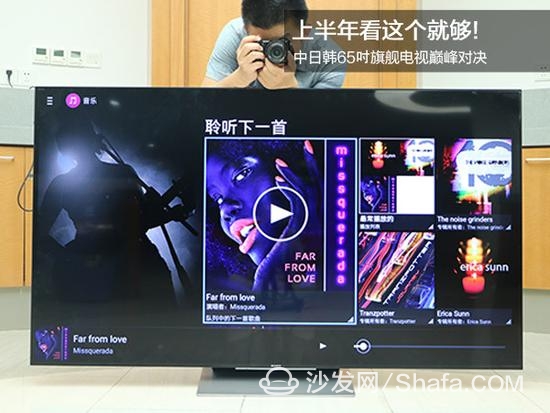
This is a horizontal evaluation, but Xiao Bian hopes to evoke televisions that are soon forgotten by young people and reshape their position in your mind. When you are running, you know to use running shoes. When you play basketball, you know to use basketball shoes. When you look at the godfather with a large mobile phone, does it feel out of place?
Do not talk nonsense too much. The four TVs that are to be cross-reviewed today have already appeared in the previous in-depth evaluation. They are all 65 inches in size, and they will be one size that will become more popular in the future. Do not think too much, the TV is not holding in one's hand to play, the panorama and the virtual display equipment are so fiery, believe me you will never be disgusted with the TV screen. Combining them today is equivalent to a summary of the flagship of the TV market in the first half of the year.
65-year-old flagship TV cross-evaluation finalists models in the first half of 2016: (in no particular order)

4 TVs Two domestically produced two Japanese and Korean products, Japan and South Korea needless to say, despite the decline in marketing in recent years, but the technical strength has always been there. The deepening of domestically-made love may be more people who may be called for, but actually it has made remarkable progress in technology and technology.
Hengping explanation:
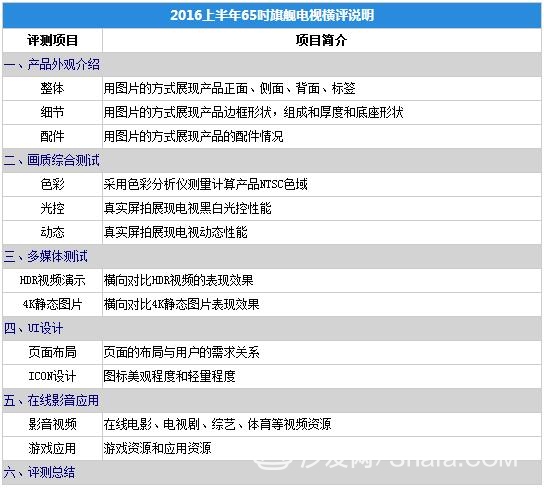
Product appearance introduction
First come a group of overall positive appearance contrasts.

Samsung KS9800 and TCL C2 are curved screen TVs with 4000R curvature, while Sony X9300D and Skyworth S9-I are flat-screen TVs. Four TVs have adopted ultra-narrow frame design. The actual contrasts among the three devices except TCL have adopted ID-free frame design, and the screen share is very high. The frame is also made of metal materials, the base has its own characteristics, the overall style is relatively simple and stylish. Sony's profile is more intense and more rigid; Samsung and TCL are also biased toward curves because of the curved screen design; Skyworth's bottom speaker design makes it look “activeâ€.
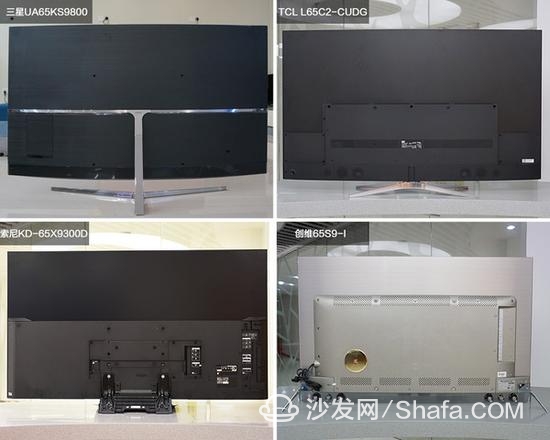
The impressive design of the back was also Samsung KS9800, which adhered to the concept of screw removal, combined with the use of a backlit waterboard, and a metallic arc extending from the base, just like a pencil sketch consisting of countless lines. Strong sense of art. In the four TVs, Skyworth's S9-I uses a metal back plate + plastic backshell design. The other three models all use plastic backshells. This is a matter of opinion. Of course, metal can still provide more stable support and protection. . Worthy of praise is that Sony X9300D in order to maintain the integrity of the back, most of the cables and interfaces are hidden under a cover, but also deliberately reserved a few clips to organize the cable, set aside space under the base Directly exported, very beautiful and user-friendly design.
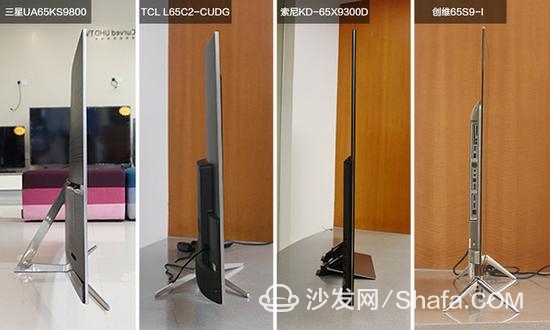
Side view still looks like Samsung KS9800 is the most personalized, Sony X9300D is still very tough, Skyworth S9-I shows more rounded design elements, and TCL C2 body slightly back, to meet the surface of the screen, more in line with the human eye The habit of watching. Regarding the thickness of the fuselage, Skyworth S9-I uses OLED panel technology to reduce the LED backlight and achieve an amazing 5.27mm thickness. The other three models are all LCD TVs, and their thickness is controlled within 13mm, which is a slim line.
Let's take a look at the details of each TV.
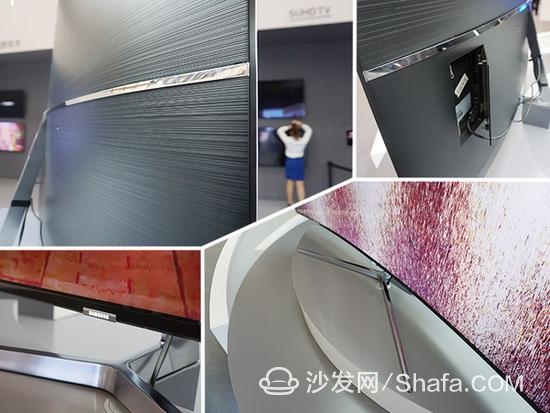
Samsung KS9800 seems to be unable to find too much detail, but it seems that the details are everywhere, flawless border design, breaking the technical bottleneck, making the overall slim. In addition, with the horizon base design, the metal brackets and bases across the entire screen are perfectly integrated. The “one-piece†design without any faults completely releases the beauty. What is even more amazing is the Samsung KS9800's philosophy of removing the screws and the use of the water backplane. It has achieved a 360-degree, non-dead-end design and is an all-in-one ultra-thin, which looks like a work of art from every angle.
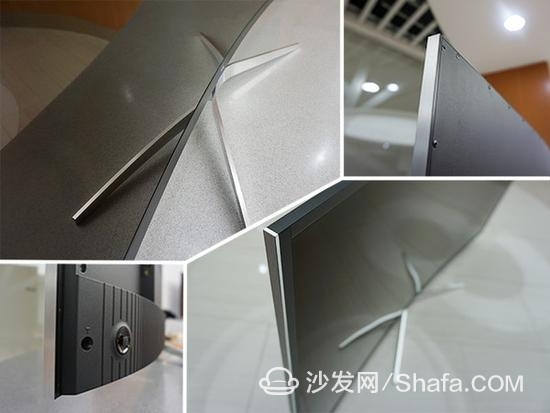
The TCL C2 is designed in such a way that the large-screen + ultra-thin + curved surface has a better visual perception, along with the strength of the fuselage, while the TCL C2 uses a double reinforced shaft, aluminum-titanium alloy back plate, curved edging The design, the triple craft makes the overall thickness of the TV to the minimum, but does not appear shaken, the distortion and so on quality question. The base looks a bit similar to the Samsung KS9800 from the front, but it is not. Samsung's is Y-shaped, and TCL is X-shaped. The X longitudinally-combined base, brand-new mechanical design and all-metal materials ensure a sufficiently strong support force. Minimalism is refined once more, and there is a light luxury.

If you want to talk about the simplicity of these TVs, then Sony X9300D is simply simple to the bone marrow, no matter from which angle to observe it, you can not find any extra, drag and drop. Its combined metal base, while ensuring stability, only exposed a complete face in frontal vision. Although the installation method is complex, the complex interior reveals the appearance of calm water. The addition of golden lines on the border also makes it a distinctive finishing touch, as well as the idea of ​​back cable finishing, so that visual effects and functionality are perfectly matched. The design of Sony's products does not change its heart. The spirit of "Slice of Living", which is life-orientated, gives this TV a more "resistant" look.
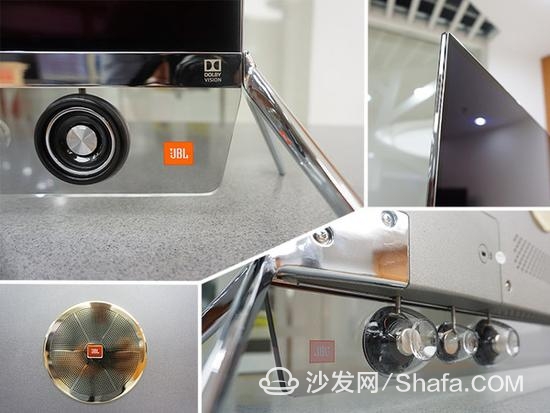
Skyworth S9-I's front-to-bottom frameless design breaks through the visual boundaries. The ultra-thin body and the material of the metal and brown acrylic transparent panel also enhance the texture of the TV. The frame is made of a rounded metal R chamfer, which complements the metal back, and the texture of the brushing not only enhances the nobleness, but also outlines the beauty. The thickness of the fuselage is even more impressive, and there are few 5.27mm TVs. There is also a very unique place, it is equipped with a JBL full range audio combination, positive brown acrylic panel inlaid with 6 JBL original speakers, the back also has 12cm large diameter "Golden Eye" JBL subwoofer, is to add luster to the appearance, Also meet the demand for super-high sound quality.
Chicken soup finished drinking mouthwatering cold water. If the evaluation of television is based on the evaluation of a painting, creativity takes 50 points and technology takes 50 points. That is, the design style, overall appearance accounts for 50%, materials and details account for 50%. If you have to decide whether to win a victory, Xiao Bian still prefers the design of Samsung and Sony. Of course Skyworth's 5.27mm ultra-thin and JBL audio combination, as well as TCL's X vertical fit base, these details are also bright spots.
Comprehensive quality test
Comprehensive quality test
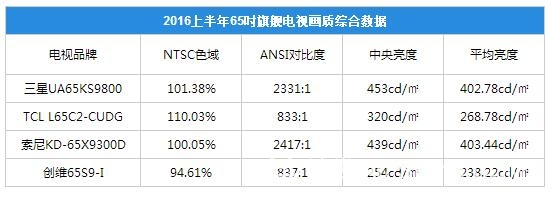
The data will not lie, of course, the data is not the only one. The quality of television has both its objective side and its subjective side. Perhaps you like the truth of quantum dots, or the richness of OLED, or they are full of praise for them. But maybe objective data does not favor your preferences.
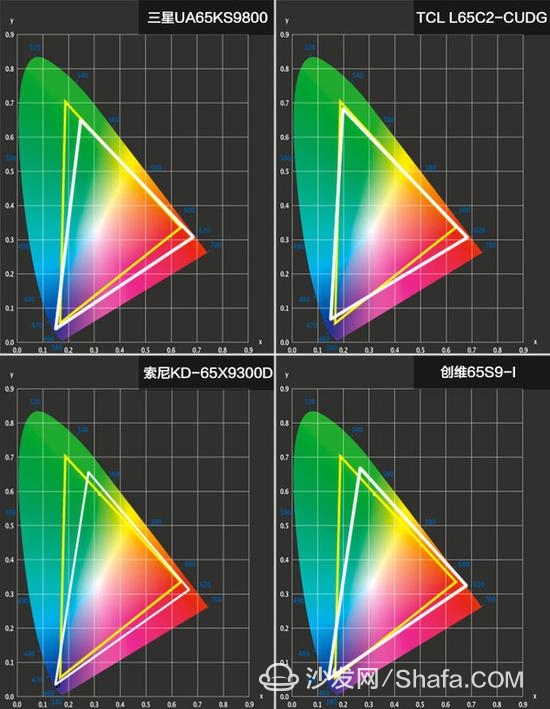
NTSC color gamut data of all four TVs is 100% up and down. From the color gamut diagram, it can be seen that the reduction of TCL C2 trichromatics is more balanced and the overall performance is the best. Skyworth S9-I with OLED panel is performing red and green. It's very extreme. Specific performance or see proofs speak.

The above figure is a tricolor map used to observe the color transition. The comparison result is still quite obvious. There are some split feelings in the transition of red, yellow, green and blue-violet violet between two domestically produced TVs, which is not as smooth as Samsung and Sony. Sony X9300D has a more obvious fault in the middle of the green. Comprehensive observation, Samsung KS9800 best performance.
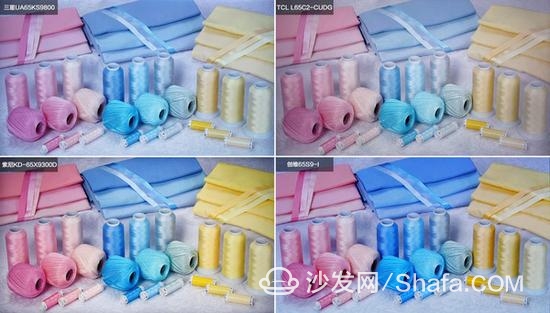
This silk standard test screen is used to consider the color reproduction capabilities of the screen. From a look-and-feel perspective, Skyworth's S9-I with OLED panel is expected to be the most glamorous, and in the remaining three LCD TVs, the Samsung KS9800 is relatively The most intense. In terms of color accuracy, the Sony X9300D is closer to the real thing.

This picture shows the overall brightness performance of the TV screen and the brightness uniformity. Brightness is consistent with the data in the table above, Samsung KS9800 and Sony X9300D use a more advanced backlight technology, have a better brightness performance, and more detail at the level of detail. It is interesting that the Skyworth S9-I has a cool style when it comes to rendering this picture.

16 grayscale proofs, Samsung KS9800 brightness is relatively high, basically every level can be distinguished. The other three stations were basically planted on the three steps of 0/1/2. However, it can be distinguished when it is actually viewed with the naked eye, but it is not as obvious as the Samsung KS9800.
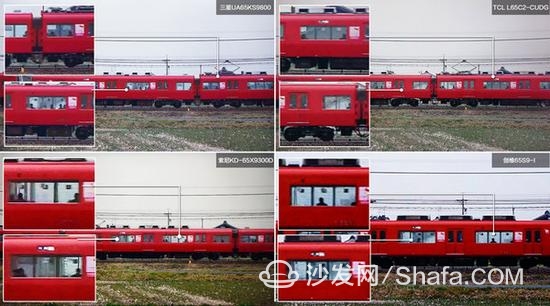
In terms of dynamic performance, almost none of the four TVs have much difference. MEMC motion compensation technology is also used, and the official refresh rate, delay, and other data are relatively close. So now the flagship model, under normal circumstances is not to worry about tailing, delays and other phenomena, unless your film source is bad enough, then no matter how good the compensation technology will not help.
Multimedia test
Multimedia test
This year is the year of the outbreak of HDR technology. Almost all TV manufacturers have applied this technology to their own flagship TVs. Sony, Samsung, and TCL have adopted a new backlight system. The peak brightness of the TV can reach 1000nit. , In the hardware technology to meet the high dynamic range of HDR, can simulate the brightness, color and details of various scenes in the real environment as much as possible. In this session, we will compare the performance of four TVs in the HDR source and the normal 4K still pictures.
HDR screen demo
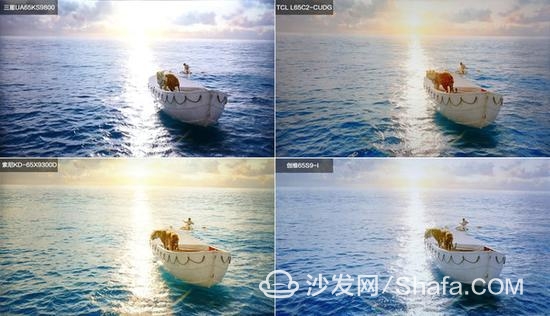
The performance of the four TVs for the video is beyond the expectation of the author. Each TV has its own characteristics in terms of color, brightness and detail. However, loyal to the original film, Sony is more realistic in terms of color. One of the most important features of HDR is that bright areas can light up, dark areas can go dark, and the details of bright and dark areas should be maintained, as well as the richness of light and dark levels. Limited by the display equipment of shooting equipment and netizens, it is not enough to fully demonstrate the true effect of each TV. But according to the author's visual experience, this picture gives me the feeling of real sunlight, the Samsung KS9800 and the Sony X9300D perform even more strongly.

Brightly lit lake at night. Can obviously feel that Samsung KS9800 has a higher light and dark contrast, the overall color trend is more true. In terms of detail, the Skyworth S9-I portrays a good picture, and the overall picture is lit up. The first thing to see is to talk about details. The TCL C2 is very rich, even a little over, and the red is overdone, which is the highest color gamut of the four TVs.
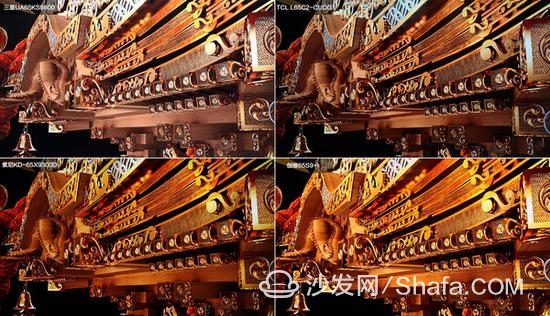
This is a very texture building, and the performance of the four TVs on the texture, I think the Sony X9300D the most pleased with the eyes. It is neither excessively rich or dark nor does it erase the texture of the building in order to lighten the picture.
4K static picture presentation
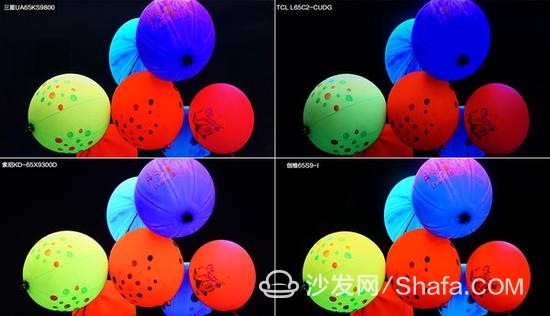
This picture is very easy to see that the difference is a blue-purple balloon. The Sony X9300D and Skyworth S9-I will be more full-bodied and the colors will feel even more transparent. It is strange that the Samsung KS9800 is a bit too strenuous for the performance of this picture. The details and color are not prominent. While the TCL C2 brightness bottom, but the details and space volume on the optimal realization.
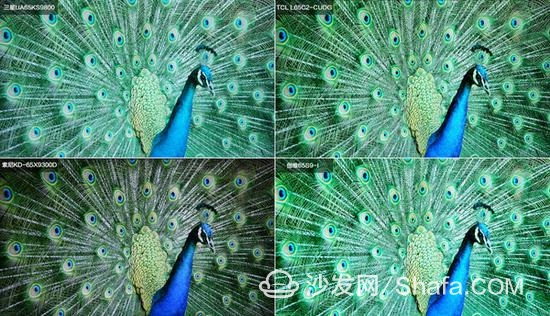
Peacock opens screen. If it is faithful to reality, the TCL will move back to the next round. The performance of green and yellow is more realistic, and Samsung and Skyworth are too much affected by blue. As for Sony, this bureau declined to comment.
UI design
UI design
Smart TVs have also embarked on the path of smart phones. Various manufacturers are deeply customizing their TV operating systems in order to obtain differentiation and personalization and to implant their own content. Domestically produced TVs are based on open source Android. Most of them are logically convergent. However, each manufacturer has its own standards in terms of content and layout, and ICON design. Therefore, it makes sense to compare them with each other.
Page Layout
Very old and middle-aged people complain that the smart TV operation is too complicated and will give up after a few decisions. In fact, this is closely related to the layout of the page, the logic of operation, and the degree of icon recognition in the process of customizing the system. A good TV operating system does not require users to spend too much on learning costs, deliberately go to the habit, but can naturally guide users to facilitate the operation.
First we will take a look at the page layout of the four TV operating systems.
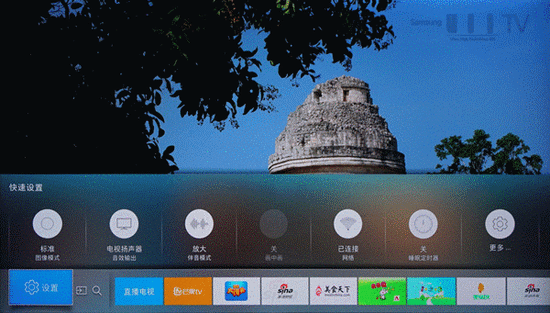
Tizen
The Tizen operating system of the Samsung KS9800, the main UI icons under the main page are located at the bottom of the bottom of the operation does not affect the normal playback of TV content in the upper part. The concept of film and television as the core is even more profound. In the arrangement of the tabs, it is streamlined into five settings: setting, source, search, live broadcast, and application. It is very streamlined and practical.
TV+OS 3.0
TCL C2 TV + OS 3.0 also uses the left and right sliding operation layout, classification is relatively simple and very direct, different above several, the K song this function directly on the desktop, you can see TCL for home entertainment.

BRAVIA_Android 5.1.1
The system of the Sony X9300D can be said to be the closest to native Android systems. Starting from the boot screen, you can feel the taste of the thick native Android system. There is a refreshing feeling, the bottom of the set, WIFI and other buttons also directly follow the native Android system icon.
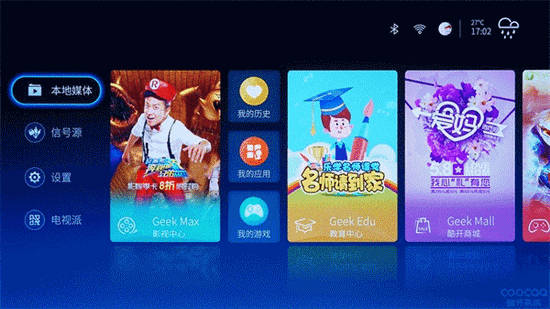
Cool open operating system 5.1
Skyworth's Coocaa 5.1 uses film and television as the first focus to spread to the periphery, and the core functions are easily found under the main page. The signal source and USB peripherals are hidden on the left side, taking into account the neat layout, but also take into account the user's needs.
ICON design
A few years ago, in the 3D TV era, most of the TV operation interfaces were still materialized, and if they were overwhelming, they came to the fore. From the mainstream mobile operating system, we can easily find that this flat and lightweight design is more and more popular

ICON design of four smart TV operating systems all adopt this style concept. Magnet card icon effects, very low-key picture, and illustrated menu design. If there are differences, then only the slight difference in the main tone and details. Now.
Card-like icons are either polished or angular, while Tizen has a frosted glass effect, and the font icons are relatively small and relatively breathable; TV+OS 3.0 is more compact; Sony's Android 5.1.1 is relatively smart; and the cool open operation System 5.1 is also lighter.
From the perspective of color matching, there are uniform color tones under different columns, plus a background gradient or translucent treatment, so that the interface does not appear cluttered and has a light sense of space.
Resources and Applications / Summary of Hengping
Resources and Applications
One of the things that domestic TV manufacturers have done most of all these years is the construction of content ecology. No matter whether it is a cross-border trader who is involved in the industry or a traditional manufacturer with a lot of qualifications, they are fighting for this piece of fat, although they are not yet familiar with it. Because only making money from hardware has not been played anymore, there are too many subversives to stir up the front and back, and the bucket of water is still very beautiful. Therefore, content profitability and advertising distribution have become a new way for domestic television manufacturers to make money. However, this will inevitably lead to a lack of success. Japanese and South Korean manufacturers did not regard this matter as the highlight.
TV
Specific to four sets of detailed video resources, pull out one way is the king. Hundreds of thousands of TV shows and millions of movies promoted by the product PPT and copywriters are the moons in the water.
However, it was only after being dragged out that it was discovered that in addition to the exclusive resources and home-made contents of each family, other resources were just like buses, and everyone was on the list.

Samsung KS9800_Mango TV

TCL C2_ICNTV/IQI
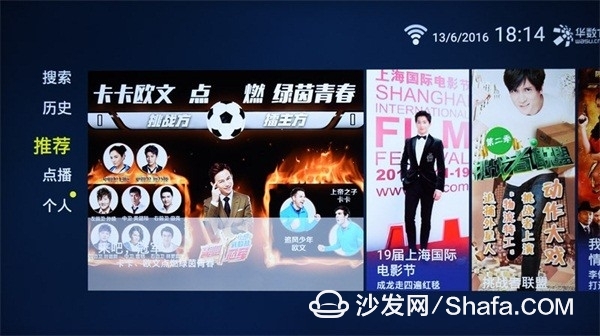
Sony X9300D_Hua TV
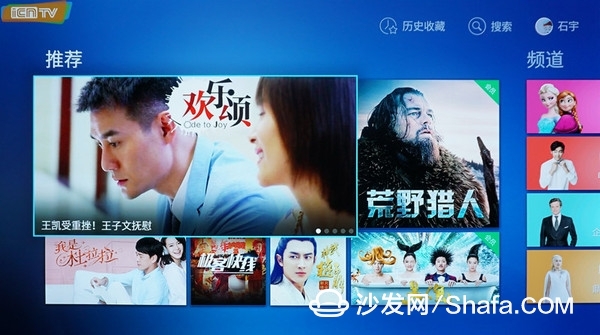
Skyworth S9-I_Tencent/ICNTV
In addition to Samsung and Sony's stiffer move to Mango TV and Wah TV, TCL and Skyworth have deeply integrated the resources of their own homes or platforms, and have also done a detailed classification. Of course, Mango and Huada also have Classification integration is only equivalent to calling a single APP, and the overall style is far away from the original Tizen and native Android.
Games and Applications
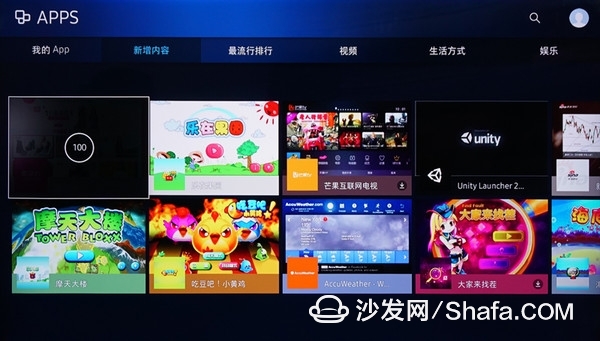
Samsung_Tizen Apps Store
The Samsung Apps Store categorizes various application software in a scientific and user-friendly manner, and provides users with classified download directories such as work, life, learning, entertainment, etc., so that consumers can easily download and manage applications that meet their needs to obtain the most Good human experience. And for users to introduce a variety of exclusive starter content, these applications can only be found in the Samsung App Store, allowing users to first-hand to play with the latest and most distinctive software, and always remain at the forefront of the era.

TCL _ Second Generation C Sports
The most outstanding TCL C2 application should belong to the second generation of C sports. This game includes badminton, tennis, table tennis, bouncing and other sports. With the use of a remote control, you can experience the joy of sports without going out of the house. The remote control is used directly as a somatosensory manipulator. Whether it is swinging a racket or throwing a javelin, the direction and speed are very accurate.
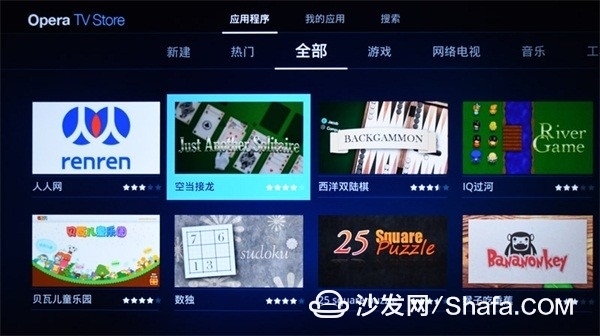
Sony _Opera TV Store
Sony's Opera TV Store also upholds the style of the native Android TV app store. Since Android is used, there is no need to worry about the application. What is impressive is that Sony has made a good experience in the design of its own application. In terms of usage, interface, Sony's own music player and video player and album are consistent with the mobile phone. And from my experience with mobile phones, at least I didn't have the idea of ​​installing a third-party alternative application.
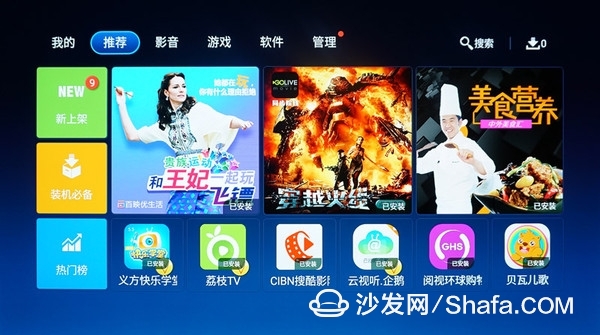
Skyworth_Cool Application Circle
Skyworth System S9-I is equipped with a wealth of resources and content. Geek Life has Geek Max video, Geek Pod music, Geek Box games, Geek Edu education, Geek Mall, Geek Travel tourism and other rich content, creating an authoritative geek Internet TV content platform. One cool application circle is an application platform designed for large-screen televisions. The quality and quantity of games and applications are well protected.
Evaluation Room Hengping Summary
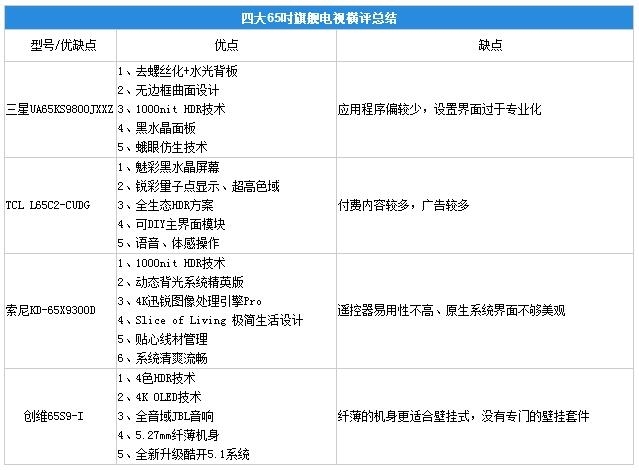
Summary: After watching such a long Hengping review, is it willing to put down your mobile phone and hand over the movie to the TV? In the first half of 2016, the four major 65-inch flagship TV crossovers are over. If you want to give a purchase proposal, I would like to define it this way: If you like fashion, pay attention to appearance and details, four TVs are for you. If on this basis, like a more cutting-edge design, more unique operating experience, then take the Samsung KS9800 home; if more emphasis on quality and image, there is a strong brand of faith, do not I say you know, Sony X9300D Waiting for you on the other side of the cold; or you prefer rich colors, more entertainment features, that TCL C2 has begun to win you a wink; Of course, if you are obsessed with the self-luminous nature of the OLED, like metal and Exaggerated sound combination, Skyworth S9-I is naturally in the arms.
Qunfang Dou Yan, are you enjoying it? Have a good TV, but also have a good TV application: sofa butler - smart TV must-have application market, watch podcast video, live broadcast with small micro-live, more interesting content with Tencent video TV version, TV, more There are TV must-have optimization tools to change the smart TV gameplay! Make your living room more colorful.
Home Appliance Voltage Protector
Household Smart Voltage Protector,Household 5A-15A Voltage Protector,Household 15A Power Voltage Protector,Household Universal Socket 30A Voltage Protector
Yuyao Huijun Electrical Appliance Co., Ltd. , https://www.yyhjdq.com